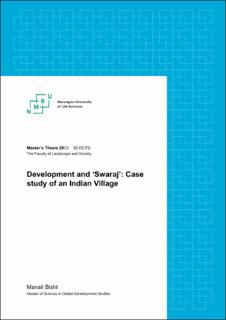| dc.description.abstract | Over the last century, many development scholars have criticised the Western model of development. There scholars argue that the Western development model has damaged the environment, increased capitalism, promoted inequitable development and increased inequality among the nations. Several alternate development approaches such as ‘Degrowth’, ‘Eco-Swaraj’, ‘Pluriverse’, ‘Buen Vivir’ have been suggested by these development scholars, that advocate the relationship between society, nature, well-being, and development. These theories focus on indigenous knowledge, regional development, village autonomy, self-sufficiency etc.
This thesis is exploring the practicality of alternate development theories on ground with a focus on ‘Swaraj’ in the Indian development context. To observe the ground reality and people’s perceptions and aspirations of development, a case study is done in a village named Kaluwala, in Uttarakhand state of India. The study is done from January 2023 to February 2023. Semi-structured interviews were the main method for data collection. The information is gathered from people belonging to different socio-economic backgrounds such as farmers, teachers, construction workers, politicians, women, representatives of village council. For interpretation of data, observations and unstructured conversations with people living and working in Kaluwala have been used.
This thesis finds that many grassroot volunteer-based development programmes are active in village Kaluwala, where people are participating actively. However, this cannot be called ‘Swaraj’, as most of these programmes are implemented and executed by the government, thus making them Top-down approaches, rather than Bottom-up approaches, as opposed to the ideas of alternating development theories such as ‘Swaraj’.
The findings also suggest that people in Kaluwala are not aware of alternate development approaches, and they could not imagine development without government help and services. Even though the prevailing development constructs are contested by scholars, the conventional notions of development seem to be embedded in the minds of people from Kaluwala.
There was also an asymmetry in the feedback regarding the information and access to the schemes and facilities available to take benefit of. This shows the mismatches between formal development plans and the local aspirations which again goes against the concept of cooperation in ’Swaraj’, where people are expected to come together for their betterment and development. In the village, there was no participation of villagers in policy making for development of the village, or any way to capture their ideas, feedbacks, or suggestions. However, in Mahatma Gandhi’s conceptualisation of ‘Swaraj’, local communities are supposed to take decisions for their development.
This thesis highlighted the practicality of alternate development approaches, especially ‘Swaraj’ in the village Kaluwala. The implementation of these alternative development policies and theories needs to be studied on a wider level, with practical approaches, keeping in mind the different development needs for different villages and communities in the World. The gap between the real world and academia needs to be reduced so that the impact of research generates some real results on ground level. | |
